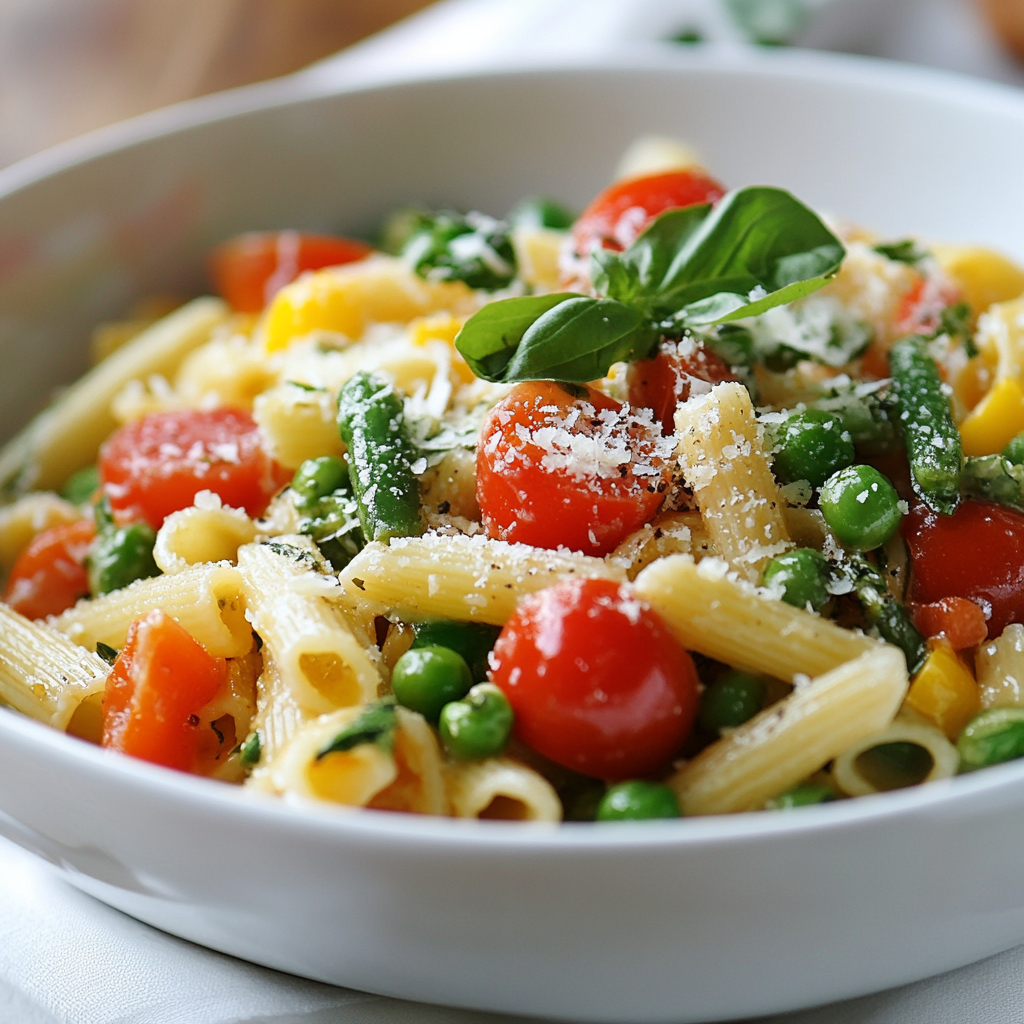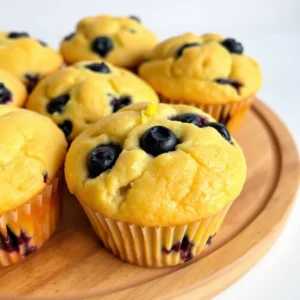Hey there, it’s Alexandre! You know those evenings when you’re staring into your fridge wondering what on earth to make for dinner? I’ve been there more times than I can count. But here’s my little secret weapon: Pasta Primavera. This dish has saved my dinner table countless times, and I’m so excited to share it with you today!
Pasta Primavera isn’t just a meal—it’s like spring sunshine in a bowl. With rainbow-colored veggies, tender pasta, and a light, zesty sauce that brings everything together, this dish practically sings with freshness. The best part? You can have it on the table in under 30 minutes, making it perfect for those hectic weeknights when everyone’s hungry and you’re running on empty.
Why You’ll Love This Pasta Primavera
There’s a reason why this dish has remained a favorite in my kitchen for years. First, it’s incredibly versatile—swap in whatever vegetables you have on hand or are in season. Got some forgotten zucchini in the crisper drawer? Throw it in! Finding creative ways to use up that bunch of asparagus? Perfect!
Second, it’s a dish that feels special enough for company but easy enough for a random Tuesday night. I’ve served this at dinner parties where guests asked for the recipe, and I’ve thrown it together while helping my daughter with homework. That kind of flexibility is worth its weight in gold, don’t you think?
Finally, it’s a healthy meal that doesn’t taste like you’re trying to be healthy. You know what I mean—those dishes where everyone at the table gives you the side-eye because they can tell you’ve gone full-on nutrition mode? This isn’t one of those. It’s just naturally packed with goodness while being absolutely delicious.
The Story Behind Pasta Primavera
While the name sounds thoroughly Italian (it translates to “spring pasta”), this dish actually has roots in North American cuisine from the 1970s. It combines Italian cooking traditions with a modern, health-conscious approach that was beginning to take hold back then.
I love that about cooking—how recipes evolve and travel, picking up new influences along the way. This dish might not be an ancient Italian secret passed down through generations, but it has definitely earned its place in the modern home cook’s repertoire.
Ingredients You’ll Need
Here’s what you’ll need to gather for this vibrant dish (serves 4):
For the pasta:
- 12 oz pasta (penne, spaghetti, or farfalle)
- 1 tbsp salt (for the pasta water)
For the vegetables:
- 2 tbsp high-quality olive oil
- 1 medium zucchini, sliced into half-moons
- 1 medium yellow squash, sliced into half-moons
- 1 cup cherry tomatoes, halved
- 1/2 cup broccoli florets, bite-sized
- 1/2 cup asparagus, trimmed and cut into 1-inch pieces
- 1/4 cup peas (fresh or frozen)
- 2 cloves garlic, minced
- 1/4 tsp red pepper flakes (optional)
- Salt and black pepper to taste
For the sauce:
- 1/4 cup extra virgin olive oil
- 1/4 cup grated cheese (or plant-based alternative)
- 1/4 cup fresh basil leaves, chopped
- 2 tbsp fresh lemon juice
- Zest of 1 lemon
How to Make Perfect Pasta Primavera
Let me walk you through creating this beautiful dish step by step:
Step 1: Cook Your Pasta Just Right
Fill a large pot with water, add that tablespoon of salt (trust me, it makes a difference!), and bring it to a rolling boil. Add your pasta of choice and cook according to package directions until it’s al dente—that perfect spot where it’s tender but still has a bit of bite.
Here’s a little trick I swear by: before you drain the pasta, scoop out about 1/2 cup of the cooking water. This starchy liquid is pure magic for bringing your sauce together later.
Drain the pasta and set it aside while you work on the veggies. Don’t rinse it—those starches on the surface help the sauce cling to every bite!
Step 2: Sauté Your Rainbow of Vegetables
In a large skillet or sauté pan, heat the olive oil over medium heat. Add the minced garlic and let it sizzle for about a minute until it becomes fragrant. Be careful not to let it brown—burnt garlic can give your dish a bitter taste.
Next, add your zucchini, yellow squash, broccoli, and asparagus to the pan. These heartier veggies need a little more time to cook. Sauté them for 5-7 minutes, stirring occasionally, until they’re tender-crisp. You want them to soften but still retain some texture—nobody likes mushy vegetables!
Now add the cherry tomatoes and peas. These need less time, just 2-3 minutes to warm through. The tomatoes will start to release their juices, adding wonderful flavor to your dish. Season everything with a sprinkle of red pepper flakes (if you like a hint of heat), salt, and freshly ground black pepper.
Step 3: Create the Fresh, Zesty Sauce
While your vegetables are cooking, quickly whisk together 1/4 cup extra virgin olive oil, grated cheese, lemon juice, and lemon zest in a small bowl. Season with a pinch of salt and pepper.
This light, citrusy sauce is what makes Pasta Primavera so special—it enhances the natural flavors of the vegetables without overwhelming them. The lemon adds brightness, the cheese brings richness, and the olive oil ties everything together.
Step 4: Bring It All Together in Perfect Harmony
Now for the fun part! Add your cooked pasta directly to the skillet with all those beautiful vegetables. Pour the sauce over everything and toss gently until every strand or piece of pasta is coated with sauce and mingled with the vegetables.
If the mixture seems a bit dry, this is where that reserved pasta water comes in handy. Add it a tablespoon at a time, tossing as you go, until you reach the perfect consistency. The starch in the water helps create a silky sauce that clings to the pasta.
Step 5: Add the Finishing Touch
Transfer your Pasta Primavera to a serving dish or individual plates. Sprinkle generously with freshly chopped basil and an extra bit of grated cheese if you like.
Serve it right away while it’s warm, and watch as everyone’s eyes light up at the sight of this colorful, fresh meal. There’s something so satisfying about presenting a dish that looks this vibrant and appetizing, isn’t there?
Tips for Making the Best Pasta Primavera Every Time
After making this dish about a hundred times (no exaggeration!), I’ve picked up some tricks that take it from good to absolutely fantastic:
Play with Your Vegetables
While the classic combination I’ve shared is foolproof, don’t be afraid to switch things up based on what’s in season or what’s lingering in your refrigerator. Here are some seasonal swaps I love:
- Spring: Add tender young peas, pencil-thin asparagus, and baby spinach
- Summer: Try sweet corn kernels, bell peppers, and fresh cherry tomatoes from the garden
- Fall: Incorporate roasted butternut squash cubes or Brussels sprouts
- Winter: Toss in some kale, sun-dried tomatoes, or roasted cauliflower
Remember, the beauty of Pasta Primavera is its adaptability. I’ve made it with just three vegetables when my fridge was nearly empty, and it was still delicious!
Getting the Texture Just Right
The secret to restaurant-quality Pasta Primavera is getting all those textures perfect. Here’s how:
- Don’t overcook your pasta – Nobody wants mushy noodles! Test it a minute before the package says it’s done.
- Stage your vegetable cooking – Add vegetables to the pan in order of how long they take to cook. Hard veggies (like carrots) go in first, delicate ones (like spinach) at the very end.
- Keep vegetables tender-crisp – If your broccoli flops over when you pick it up, you’ve gone too far! You want vegetables that still have some life in them.
- Reserve that pasta water – I know I mentioned this before, but it’s worth repeating. That starchy water is the difference between pasta that’s coated in silky sauce and pasta that’s dry and clumpy. And if you’re like me and sometimes forget to save it (oops!), just add a splash of hot water and a touch more olive oil.
Make It a Complete Meal
Sometimes you want a heartier version of this dish, especially if you’re feeding hungry teenagers (I know this challenge all too well!). Here are my favorite protein additions:
- Grilled chicken breast, sliced thin
- Sautéed shrimp (they cook in just minutes!)
- Cannellini beans for a vegetarian protein boost
- Cubes of firm tofu, marinated and pan-fried
Just add your protein of choice right before tossing everything together, and you’ll have a complete one-dish meal that satisfies even the biggest appetites.
“Mom, Can We Have That Rainbow Pasta Again?”
The first time I made Pasta Primavera for my family, my daughter Emily (who was seven at the time and going through a serious picky-eating phase) looked at her plate skeptically. All those vegetables were setting off her “healthy food alarm.”
But I had a trick up my sleeve. “This is rainbow pasta,” I told her with a conspiratorial wink. “Each color gives you a different superpower.”
She cautiously took a bite, then another. By the end of dinner, her plate was clean, and she was asking what superpower the yellow squash gave her. (Quick thinking on my part: “The ability to remember everything you study for tests!”)
Now, years later, “rainbow pasta” is still requested at least twice a month at our house. Sometimes the simplest rebranding is all it takes to win over the toughest food critics!
Your Pasta Primavera Questions Answered
Can I make Pasta Primavera ahead of time?
You can prep all the components in advance, but I recommend assembling just before serving for the best texture. Chop all your vegetables and store them in the refrigerator, cook and refrigerate your pasta tossed with a tiny bit of oil to prevent sticking, and mix your sauce ingredients. When dinner time rolls around, you can have everything heated, tossed, and on the table in about 10 minutes. If you do have leftovers, they’ll keep in the refrigerator for up to 3 days—just know that the vegetables won’t be quite as vibrant after reheating.
What’s the best pasta shape for Pasta Primavera?
While you can use any pasta you have on hand, shapes that catch and hold the vegetables and sauce work best. My personal favorites are farfalle (bow ties), penne, or rotini (spirals). These shapes have nooks and crannies that trap those lovely bits of vegetables and sauce. That said, there’s something elegant about using spaghetti or linguine—just twirl your fork and get a perfect bite of pasta and vegetables together!
Can I make this dish gluten-free or dairy-free?
Absolutely! This is one of those wonderfully adaptable recipes. For gluten-free, simply swap in your favorite gluten-free pasta. Just be sure to check the cooking time, as it sometimes differs from traditional pasta. For dairy-free, either omit the cheese altogether (the dish is still delicious without it) or use a plant-based cheese alternative. The lemon and olive oil provide plenty of flavor on their own.
The Joy of Simple Cooking
What I love most about dishes like Pasta Primavera is how they remind us that good cooking doesn’t have to be complicated. With just a handful of fresh ingredients and about 30 minutes, you can create something truly special that nourishes both body and soul.
In my kitchen, the best recipes are the ones that leave room for improvisation and personal touches. Pasta Primavera is the perfect canvas for your creativity—whether you’re using up vegetables from your garden, incorporating seasonal finds from the farmers’ market, or simply working with whatever you have in your refrigerator.
I hope this Pasta Primavera becomes a beloved staple in your kitchen, just as it has in mine. There’s something deeply satisfying about setting a colorful, homemade meal on the table, especially on busy weeknights when time is precious. It’s these everyday moments—sitting down together over a simple but delicious dinner—that often become our fondest memories.
So the next time you’re wondering what to make for dinner, remember this fresh, versatile Pasta Primavera. It’s more than just a meal—it’s a celebration of seasonal produce, simple cooking, and the joy of feeding those you love.
More Delicious Recipes to Try
If you enjoyed this Pasta Primavera, you might also love these other dishes from my kitchen:
- Quick and Easy Vegetable Stir Fry – Another versatile weeknight dinner that makes the most of fresh vegetables
- Creamy Garlic Parmesan Risotto – When you’re in the mood for something a bit more indulgent
- Mediterranean Chickpea Salad – A perfect light lunch or side dish
For more information about cooking with seasonal vegetables, check out this helpful Seasonal Produce Guide from the USDA.
And if you’re interested in learning more about the nutritional benefits of colorful vegetables, the Harvard School of Public Health has an excellent resource on this topic.
Happy cooking, friends! Until next time, remember that the best ingredient in any dish is the joy you bring to making it.



